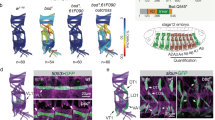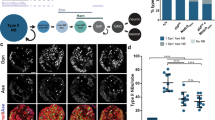Abstract
IN the Drosophila embryo, mutations in the segment polarity gene patched (ptc) cause the replacement of the middle region of each segment by a mirror-image duplication of the remaining structures, including the parasegmental border1–3. This gene, which encodes a transmembrane protein, is initially expressed in a generalized way at blastoderm, but later stops being transcribed in cells expressing the engrailed gene, and even later in cells in the middle of the parasegment2–4. The genes engrailed (en) and wingless (wg) are also segment-polarity genes, and they are expressed in adjacent stripes flanking the parasegment borders in the embryo5; in ptc mutants wg expression extends anteriorly and an ectopic stripe of en expression is induced6,7. The suggestion has been made that ptc must be transcribed in a specific subset of cells to prevent en expression anterior to the wg-expressing stripe4. Here we report that unrestricted expression of ptc from a heat-shock promoter has no adverse effect on development of Drosophila embryos. The heat-shock construct can also rescue ptc mutants, restoring wg expression to its normal narrow stripe. The ectopic en stripe fails to appear, but the normal one remains unaffected. The results imply that, despite its localized requirement, the restricted expression of ptc does not itself allocate positional information.
This is a preview of subscription content, access via your institution
Access options
Subscribe to this journal
Receive 51 print issues and online access
$199.00 per year
only $3.90 per issue
Buy this article
- Purchase on Springer Link
- Instant access to full article PDF
Prices may be subject to local taxes which are calculated during checkout
Similar content being viewed by others
References
Nusslein-Volhard, C. & Wieschaus, E. Nature 287, 795–801 (1980).
Nakano, Y. et al. Nature 341, 508–513 (1989).
Hooper, J. E. & Scott, M. P. Cell 59, 751–765 (1989).
Hidalgo, A. & Ingham, P. Development 110, 291–301 (1990).
Ingham, P., Martinez-Arias, A., Lawrence, P. A. & Howard, K. Nature 317, 634–636 (1985).
Martínez-Arias, A., Baker, N. & Ingham, P. Development 103, 157–170 (1988).
DiNardo, S., Sher, E., Heemskerk-Jongens, J., Kassis, J. A. & O'Farrell, P. H. Nature 332, 604–609 (1987).
Baker, N. E. Devl Biol. 125, 96–108 (1988).
Mohler, J. Genetics 120, 1061–1072 (1988).
DiNardo, S. & Heemskerk, J. Semin. Cell Biol. 1, 173–183 (1990).
Ingham, P. Nature 335, 25–34 (1988).
Spradling, A. & Rubin, G. Science 218, 341–347 (1982).
Struhl, G. Nature 338, 741–744 (1989).
Smith, D. S. & Johnson, K. S. Gene 67, 31–40 (1988).
Macdonald, P. M. & Struhl, G. Nature 324, 537–545 (1986).
Nüsslein-Volhard, C. Wieschaus, E. & Kluding, H. Willhelm Roux Arch. devl Biol. 193, 267–282 (1984).
Cohen, S. M. & Jurgens, G. EMBO J. 8, 2045–2055 (1989).
Tautz, D. & Pfeifle, C. Chromosoma 98, 81–85 (1989).
Baker, N. E. EMBO J. 6, 1765–1773 (1987).
Author information
Authors and Affiliations
Rights and permissions
About this article
Cite this article
Sampedro, J., Guerrero, I. Unrestricted expression of the Drosophila gene patched allows a normal segment polarity. Nature 353, 187–190 (1991). https://doi.org/10.1038/353187a0
Received:
Accepted:
Issue Date:
DOI: https://doi.org/10.1038/353187a0
Comments
By submitting a comment you agree to abide by our Terms and Community Guidelines. If you find something abusive or that does not comply with our terms or guidelines please flag it as inappropriate.



